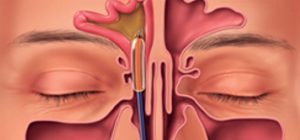By Michael Branch, MD
 What is sinusitis, and how long does it last?
What is sinusitis, and how long does it last?
Chronic sinusitis affects nearly 30 million people in the United States each year.1 Inflammation of the sinuses within the nose and head interferes with how mucus drains and can cause difficulty breathing through the nose due to the inflammation of the nasal passages. Acute sinusitis is usually relieved within a short period of time, but with chronic sinusitis, it can linger for many weeks and reoccur multiple times.
Sinusitis Causes and Symptoms
While some people are predisposed to inflammatory disorders, which can intensify chronic sinusitis, other causes include environmental toxins such as molds and exposure to chemicals or other irritants. Some individuals’ immune systems may make it difficult to fight off viral and bacterial conditions that contribute to sinus infections. Nasal polyps can exacerbate sinusitis, as do allergies and a deviated septum. Chronic sinusitis typically lasts several weeks to several months, although many people suffer with it daily.
Chronic Sinusitis Symptoms:
• Postnasal drip
• Pressure in the sinuses and head
• Inflamed or congested nasal passages
• Mucosal discharge or a runny nose
• Discomfort around the eyes, forehead, cheeks, and nose
• Ear infections or pain
• Sore throat (irritation from postnasal drip)
• Reduced sense of taste and smell
Sinusitis Treatment
Typically, people may attempt to self-treat their sinusitis symptoms with allergy medicine, nasal washes, nasal spray, and pain reliever; however, these are often not enough to control chronic sinusitis.
In the initial stages, primary care practitioners or ENTs (Ear Nose and Throat/otolaryngologist) might prescribe antibiotics, nasal sprays, and steroids to control the inflammation and reduce the bacterial load.
In the past, severe sinusitis was treated by surgically removing sinus bone and tissue to make an opening for the sinuses to drain through the nose. While this surgery is still used in some cases, today, an advanced, minimally invasive procedure has helped countless people overcome their chronic sinusitis disorder—Balloon Sinuplasty.
Balloon Sinuplasty
Balloon sinuplasty is a minimally invasive procedure designed to open and drain inflamed sinus passageways by inflating a small balloon. There is no cutting or removal of bone or tissue. This process helps relieve sinus pressure, congestion, trouble breathing through the nose, nasal discharge, and many other sinusitis symptoms.
ENT doctors adapted this balloon technique from balloon angioplasties, which use a balloon to open up blocked arteries.
The Balloon Sinuplasty takes about 30 minutes and is minimally invasive and can be performed in an outpatient setting. During the procedure, your surgeon will insert a tiny wire catheter through your sinus passageways. This wire is used to guide a deflated balloon up into your natural sinus openings. The balloon inflates slowly, which opens up the blocked passage into the sinuses. This allows mucus to drain and the sinus to re-aerate itself (receive airflow). Then, the balloon is deflated and removed.
When compared to other sinus surgeries, balloon procedures have many benefits, including:
• Faster recovery
• Fewer side effects and risks of complications
• Lower risk of infection
• Shorter procedure time
• No hospital stays (as they often can be performed in the comfort of your ENT’s office)
Good candidates for this procedure typically include people who:
• Have chronic sinusitis (long-term inflammation of sinuses)
• Don’t have other sinus or nasal issues, such as polyps or a deviated septum
• Have symptoms that haven’t improved with other treatments or medications
If you’ve been struggling with chronic sinus problems and want to learn about all your options, it’s time to talk to an ENT for help.
Dr. Branch specializes in performing balloon sinuplasty—and helping patients breathe easier. To schedule your appointment, please (813) 778-0101 or visit
FloridaMedicalClinic.com.
Michael Branch, MD
A musician at heart, Dr. Michael Branch spent time as a rock ‘n’ roll drummer and later as an operating room technician in the US Air Force. After training, he was an active-duty ENT medical officer with the US Navy and has been an ENT surgeon for 29 years. He joined Florida Medical Clinic in 2019. Dr. Branch is certified by the American Board of Otolaryngology.
In addition to performing balloon sinuplasty, Dr. Branch specializes in treating hearing loss, ear disease, chronic hoarseness, and other ear, nose, and throat conditions.
813.778.0101
New Tampa
15285 Amberly Dr.
Tampa, Fllorida 33647
Zephyrhills
36763 Eiland Blvd., Suite 103
Zephyrhills, Florida 33542
Reference:
1. Rosenfeld, R.M., Piccirillo, J.F., Chandrasekhar, et al. (2015).
Clinical Practice Guideline (Update): Adult Sinusitis.
Otolaryngology–Head and Neck Surgery. Vol. 152(2S) S1–S39.
 Central Florida Health and Wellness Magazine Health and Wellness Articles of the Villages
Central Florida Health and Wellness Magazine Health and Wellness Articles of the Villages



